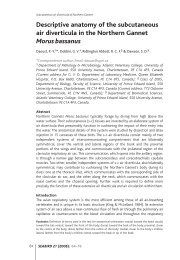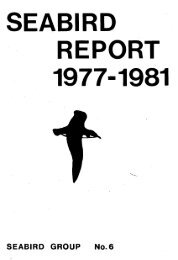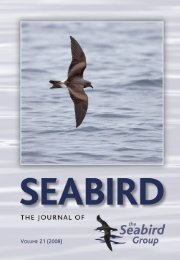You also want an ePaper? Increase the reach of your titles
YUMPU automatically turns print PDFs into web optimized ePapers that Google loves.
2001 Return rates of Common Terns 179<br />
THE INFLUENCE OF FLEDGLING NUMBER AND<br />
HATCHING ORDER ON RETURN RATES OF<br />
COMMON TERNS STER�A HIRU�DO<br />
T. DITTMANN, J.-D. LUDWIGS & P. H. BECKER<br />
Dittmann, T., Ludwigs J.-D. & Becker P.H. 2001. <strong>The</strong> influence of fledgling number<br />
and hatching order on return rates of Common Terns Sterna hirundo. Atlantic <strong>Seabird</strong>s<br />
3(4): 179-186. �atal characteristics of Common Terns Sterna hirundo that returned as<br />
prospecting pre-breeders to their home colony in a coastal brackish water lake in<br />
�orth-western Germany were compared with those that did not return. �o influence of<br />
either fledgling number or hatching order on return rates (mean 41%) could be found.<br />
<strong>The</strong>se findings indicate that during the stage of post-fledging care, individual parental<br />
quality becomes less important for the survival of the offspring.<br />
Institut für Vogelforschung “Vogelwarte Helgoland”, An der Vogelwarte 21, D-26386<br />
Wilhelmshaven, Germany; E-mail: tobias.dittmann@ifv.terramare.de<br />
INTRODUCTION<br />
In semi-altricial seabirds, including the Common Tern Sterna hirundo, both<br />
hatching order and number of siblings within a brood have proved to be<br />
important factors affecting chick survival until fledging (e.g. Parsons et al.<br />
1976; Spear & Nur 1994; Nisbet et al. 1995; Royle & Hamer 1998). In contrast,<br />
knowledge about the influence of both factors on post-fledging survival is<br />
limited, mainly due to methodological problems. Young Common Terns depend<br />
entirely on being fed by their parents until fledging and are still provided with<br />
food for some weeks thereafter, and possibly also during autumn migration as in<br />
larger tern species (Burger 1980). Hence, siblings within a brood may compete<br />
for food even for some time after fledging. Nisbet (1996) investigated the<br />
influence of hatching order on post-fledging survival of Common Terns, based<br />
on a small sample size, and found no effect. Most surviving Common Terns<br />
explore their home colony site as subadults when 2 years old, arriving several<br />
weeks later than breeding birds (Becker et al. 2000) and breed for the first time<br />
at an age of 3 years (Wendeln & Becker 1998; Becker et al. 2000). Return rates<br />
to their natal colony site of Common Terns in Wilhelmshaven, Germany, vary<br />
between 22% and 46% among different year classes (Wendeln & Becker 1998).<br />
<strong>The</strong> aim of the present study was to investigate effects of both hatching order<br />
and number of siblings fledged on individual survival from fledging until return<br />
to the natal colony using a large sample.








